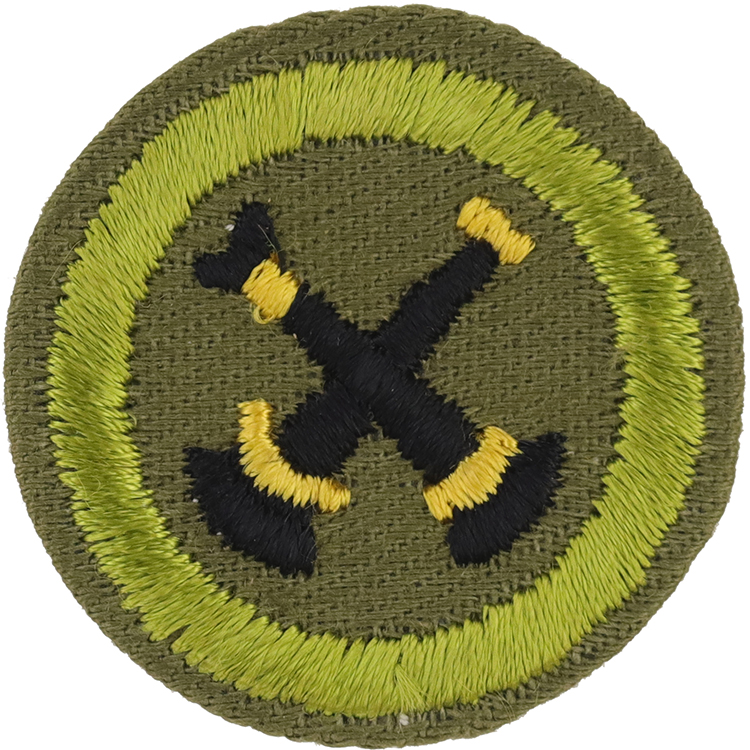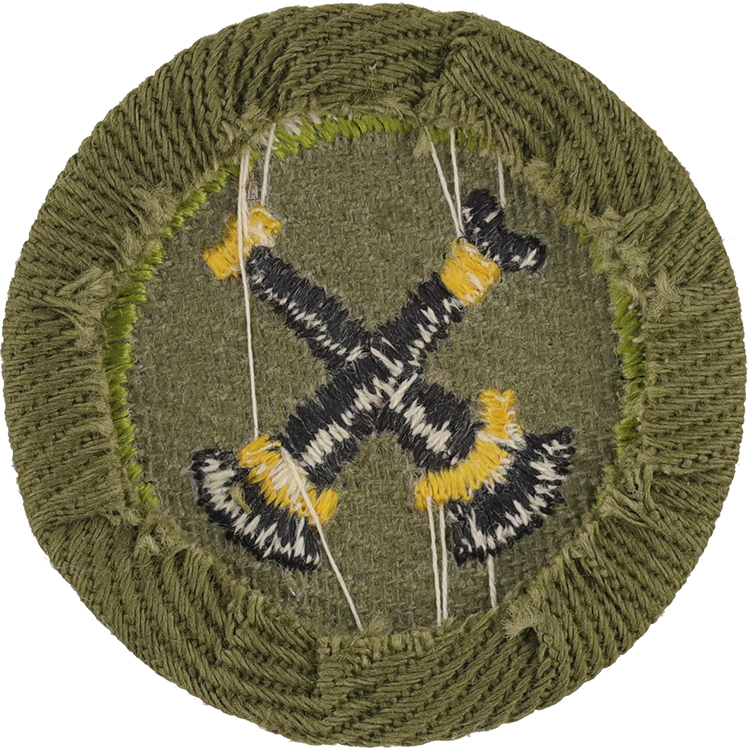
Fig. 1: Firema-E2-Front
- Cloth: Khaki right twill
- Embroidery: Cotton lock stitch

Fig. 2: Firema-E2-Reverse
- Back: Plain NO imprint with starch

Fig. 3: Firema-E2-mve1-front
- Minor variation: Wide border and wide nozzles

Fig. 4: Firema-E2-mve1-reverse
- Back: Plain NO imprint with starch
Item Name: Firemanship 1947 - 1960
Item ID: Firema-E2
Collector Rating: 1
September 1945 until January 1957
1. Explain three common causes of fire in the home (other than careless use of gasoline and kerosene) and tell how to guard against each.
2. (a) Inspect his home, fill out an inspection blank, and present it to the Counselor; (b) tell how he would plan, in case of fire at night, for every one in his home, including himself, to escape to safety; (c) list the equipment and material in his home available for fire protection and explain under what conditions each is used; (d) tell what fire fighting forces would respond to a fire alarm from his home.
3. Tell where flammable liquids such as gasoline, kerosene, and turpentine should be stored for absolute safety and under what conditions only they should be used.
4. Explain at least two causes of spontaneous ignition and tell how to guard against them.
5. (a) Light a match safety and discard it safely; (b) make a satisfactory fire pail from a gallon or No. 10 can, or make a fire beater or fire rake; (c) show what to do if caught in a room filled with dense smoke or chemical fumes; (d) give three ways of turning in a local fire alarm; tell exact location of nearest fire alarm to his home, school and Troop Meeting Room.
6. Show two steps necessary to save a person whose clothes are on fire.
7. Using proper methods: (a) build a fire in the open where there is flammable material both around and under place where fire is to be laid; (b) extinguish this fire.
8. (a) Tell how to select, prepare and maintain a camp site so that proper fire prevention will be provided at all times; (b) explain three simple ways of fighting a forest fire when fire fighting equipment is no available, and how to use three simple hand tools in fighting the fire; (c) tell whom he should notify in case of a serious fire on camping trips during the year.
9. Conduct a fire drill in his Troop.
10. Explain what his Scout Troop or Patrol can do to help the local fire fighting organization or the community prevention campaign.
Requirements 1957 until September 1962
1. Explain how heat, fuel, and air are necessary to cause fire. Describe how the elimination of any one of these will extinguish fire.
2. Explain five causes of fire in the home and tell how to guard against each.
3. Explain how fire might start from: (a) a pile of oily or paint-covered rags, (b) wet hay in a haymow, (c) electrical wiring and equipment, (d) gas connections and appliances, (e) oil-burning stoves and portable kerosene heaters.
4. With the help of your parents make a thorough fire safety inspection of your home. Then prepare the following in writing: (a) List all those things you have found in your home that could start a fire. A standard home fire safety checklist may be used. Have one of your parents sign this list. (b) Tell what you have done to correct these defects. (c) List all equipment of any sort in your home that can be used to extinguish fires.
5. (a) With your parents, list the amount and location of any gasoline, kerosene, cleaning fluid, paint, thinner, turpentine, etc., in your home, including outbuildings.
(b) Tell which of these materials were stored unsafely and what you did to correct these conditions.
6. (a) Visit the fire station nearest your home. Identify the most important pieces of equipment there and describe the purpose of each. (b) Describe the ways of turning in an alarm in your community. (c) Explain the fire problems in your local area and what is being done to solve them.
7. Make a rough sketch of the sleeping area in your home and show which persons are in what rooms. Then explain: (a) what to do if you smell smoke when you wake up at night, (b) what you should do to save yourself and your family, (c) a home fire escape plan that you have discussed with your entire family.
8. Show what you would do to save a person whose clothes are on fire.
9. (a) Tell how to set up a camp and make it safe from fire.
(b) Describe the fire equipment you should have available before lighting a fire. (c) Bring a note from your unit leader stating that you have properly put out a campfire. Describe where and how you did this.
10. (a) Tell whom you should notify in case of a serious fire on camping trips. (b) Explain how to fight a grass or brush fire with improvised equipment. (c) Tell how forest fires may start. Explain what is done to prevent them and what you may do to help.


